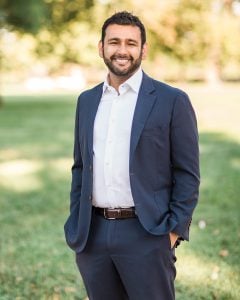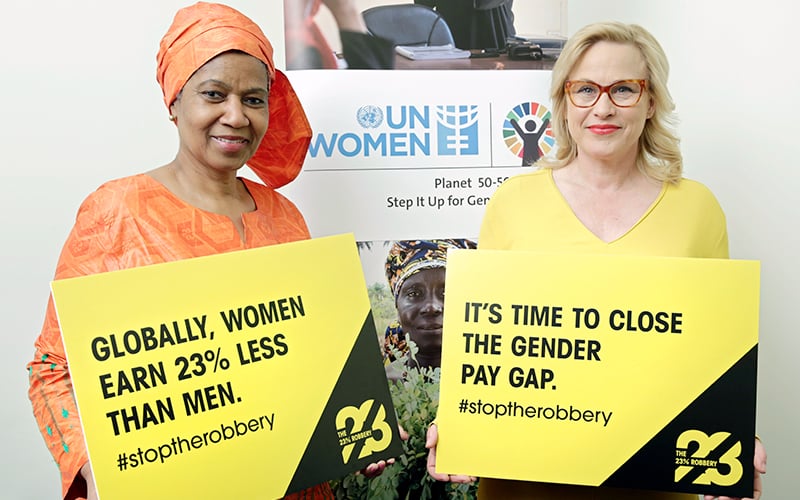
Attorney Ehsan Zaffar said actions need to follow conversations about equity. He wants to create tangible products and services to help communities reduce inequality. One concept would be an index to rate companies on an inequality scale. (Photo by Sebastiaan ter Burg/Creative Commons)
PHOENIX – Attorney Ehsan Zaffar is leading an initiative to establish a civil rights center at Arizona State University to target inequality in the U.S. To do so, Zaffar envisions a range of products, services and programs – perhaps including Yelp-like reviews of how Arizona companies address social justice issues.
“Inequality is the greatest social, political, economic problem facing this country today,” said Zaffar, a civil rights and civil liberties official with the Department of Homeland Security who will join ASU in January. “I think our country is headed back to a time when institutions were powerless to fix the problems in the country. There’s a lack of trust.”
He hopes the center’s work will help strengthen institutions by encouraging them to be more responsive to the public and to produce more factual information about social justice issues.
Zaffar said his work at the center, which will include fundraising, also could examine how news and social media cover certain communities in ways that affect lawmakers, analyze emergency response times in communities of color and explore the gender pay gap in U.S. companies.
Faculty, staff and students will work to shape the center and its actions to reduce structural inequality, Zaffar said. The yet-to-be-named center is expected to be housed in the Herald Examiner building in downtown Los Angeles, which ASU will occupy once renovations are complete in 2021.
The center is part of university President Michael Crow’s 25-point initiative to battle systemic racism and to support Black students, faculty and staff.
Zaffar, who joined DHS in 2011 during the Obama administration, had previously launched a Los Angeles mobile legal-aid clinic – a “law firm on wheels” – to provide low cost or free legal care to low-income communities.
In an interview, Zaffar, 38, talked about the interdisciplinary work of the center and some early concepts, but he emphasized that the team of students and staff members still need to be chosen and strategies and ideas selected. After the center is operating, Zaffar and his team will build programs that give students academic credit for working with the center.
What potential products could the center create?
One would be an index to rate companies on an inequality scale.
Some metrics would be quantitative, potentially exploring the gender pay gap by looking at the differences in salary between men and women in the same position who have similar work histories.
“The question the index would try to answer is, ‘Does a woman with the same background get paid less than a man? If so, how much?’”
The center also could explore qualitative factors to the pay gap, such as whether heating, ventilation and air-conditioning units are adjustable.
“Up until recently, HVAC units were designed mostly for men and their bodies. An HVAC unit that’s adjustable takes into account that there’s different people, whether they’re men, women or transgender, that have different needs.”

Ehsan Zaffar, a civil rights and civil liberties official with the Department of Homeland Security, will join Arizona State University in January to lead and develop a civil rights center. (Photo courtesy of Ehsan Zaffar)
He would also like to do grand challenges for students to create products that are adopted by companies or organizations, and a “Shark Tank” for inequality. That could be for young entrepreneurs with disposable income who want to get involved in funding good product ideas.
What problem is your initiative trying to solve?
Although society talks about inequality and how it affects people, Zaffar said actions need to follow conversations. He wants to create tangible products and services to help communities reduce inequality.
“I think that’s where the problem is. Everybody realizes there’s lots of inequality. We talk about it, we discuss it and then we just walk away.”
Products last. They can be reused, replicated and persist in society. Although none have been created yet, the products can be tools for individuals and communities that are struggling with social, political and economic issues.
Zaffar gave examples of types of products that could be useful.
Phone apps that assess news coverage could point out whether low-income communities are covered differently from high-income communities, and whether that discrepancy has any effect on legislation.
“I want faculty members and students who get involved with the center or have thought about an idea to approach me.”
Zaffar also wants the center to host competitions, such as those done by Xprize, a nonprofit that encourages people to create products that promote inclusivity and accessibility.
Do you expect pushback from companies?
Zaffar said it’s possible companies may debate the worth of such products as a rating index.
“Issues around inequality rights, sometimes they unearth something that people don’t want to see. They shed a light on something that’s not going right, and sometimes people don’t want to see that.”
People may get defensive, he said, but that’s that’s fine because that’s how change happens. His initiative is not adversarial, it’s cooperative.
He also will make sure people who work with the center do things methodically, think critically and research thoughtfully.
Basing the center at a university ensures such an approach, he said. Zaffar wants to make sure the center has valid and well-tested research before releasing a product and to use metrics to continue to improve those products.
How will the center operate?
Zaffar’s job will be to find funding to implement ideas to reduce structural inequality that students, faculty or staff bring to him. He gave an example of a student who wants to produce a speaker series on a certain topic, and if the center can help implement the series, Zaffar may help connect the student to the right person or provide them with a mentor.
“We exist to serve the needs of the ASU community on these issues, so I will do whatever I can within my power to help that student get what they need.”
He’s currently reaching out to faculty members in the Sandra Day O’Connor Law School, W.P. Carey School of Business, the Edson College of Nursing and Health Innovation and many others, to see what they’re working on and whether the center can help achieve their goal.
An example: If two faculty members mentioned they want to work on making engineering more accessible to students of color, he would connect the two and suggest they apply for a grant or find another means for funding the project. After getting funding for the project, they would reach out to students to become involved.
Who gets to work on developing center projects?
Zaffar sees himself as a facilitator to help students, faculty and staff implement creative and innovative products that can help communities.
“If there’s a faculty member who says, ‘I really want to work on issues related to the power of women in the workplace,’ it’s my job to say, ‘OK, what can we do to help you get some funding?’”
The center is designed to unify the various ideas and issues related to inequality across the campus and students could get the opportunity to do field research or statistical analysis.
“I’m looking for people that are interested in working on issues of inequality.”
Students could gain a wide range of skills, Zaffar said, including writing and communication, public speaking, statistical analysis or time management.
“I’m hoping students get a better understanding of the role that inequality plays in this country and that can help them if they go into public policy, law, engineering or business and they can take that understanding with them.”
He sees faculty members bringing a level of “research rigor” with their expertise and knowledge in specific areas, students to bring enthusiasm and various ideas to experiment with and learn from in a real world environment.
Staff can bring a little bit of both, Zaffar said.
“There’s a lot of staff on campus that have a level of expertise just like the faculty. There’s a lot of staff that have amazing ideas and the ability to implement them.”
How else will the center help communities?
One way is to “arm them with data.”
How quickly first responders react to a disaster in various communities is one aspect that could be analyzed, Zaffar said.
“Do low income communities or communities that are largely communities of color have a faster disaster response than others? That would be interesting to find out more information and maybe map it out or produce a report that talks more about it.”
Tracking certain words that are used in media coverage in different communities or the data gathered from the index on how companies treat their employees are other potential ways.
“When data is made public it ignites behavior change.”

